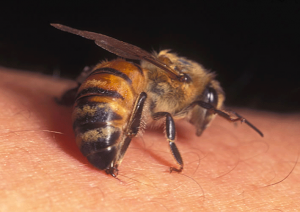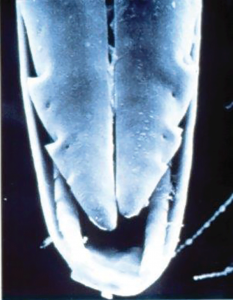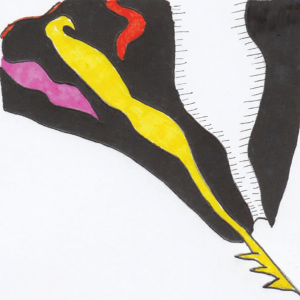Does Getting Bit by a Bee Make You Susceptible to Getting Big Again
Past: Sharla Riddle
Zap! Stings happen. Even the most experience beekeepers catch a sting occasionally.
It'south the price nosotros pay for those beautiful jars of honey. Bees aren't "seek and destroy" insects. They actually aren't  itching for a fight, and are quite content to ignore humans. Afterwards all, they take work to do. We're basically a nuisance to them, and so stinging is really a last resort for a bee. Only, they are, in the end, social insects and protecting the hive is Job 1. So if a worker bee senses a threat, it will sting so utilize alert pheromones to call in the cavalry. It's these chemic weapons in the bee'southward arsenal that have scientists fascinated. Bees are remarkable, so information technology'south little wonder that their venom is proving to be an amazingly complex and useful substance.
itching for a fight, and are quite content to ignore humans. Afterwards all, they take work to do. We're basically a nuisance to them, and so stinging is really a last resort for a bee. Only, they are, in the end, social insects and protecting the hive is Job 1. So if a worker bee senses a threat, it will sting so utilize alert pheromones to call in the cavalry. It's these chemic weapons in the bee'southward arsenal that have scientists fascinated. Bees are remarkable, so information technology'south little wonder that their venom is proving to be an amazingly complex and useful substance.
Bee venom is mostly water-88% to be exact. Because of this h2o solubility, bees sting in moist tissue in order for the venom to disperse effectively. Unfortunately, that'southward why the venom works so well on humans – we have lots of dainty moist tissue. Painful to call back near, huh? Different warning pheromones, bee venom is odorless with a pH of four.5 to five.5 which tin make it slightly acidic. Because of this acidity, some home remedies advise using a baking soda paste on stings to neutralize the stings. Near scientists doubt the effectiveness of such topical treatments. (That's because the venom is injected into skin and non onto skin.)
The allergen in bee venom that causes the main "ouch" is melittin. It's past far the near abundant ingredient in bee  venom – 50% of venom's dry weight comes from melittin. Melittin causes red blood cells at the sting site to flare-up and the claret vessels to expand. This blood vessel expansion is why some people have a dangerous drop in blood pressure level after bee stings. And, unfortunately, melittin isn't the but ingredient in bee venom that causes pain. Phospholipase A2 is another protein that works with melittin to destroy jail cell membranes at the sting site. This ingredient, which makes up 12% of venom, causes hurting and inflammation.
venom – 50% of venom's dry weight comes from melittin. Melittin causes red blood cells at the sting site to flare-up and the claret vessels to expand. This blood vessel expansion is why some people have a dangerous drop in blood pressure level after bee stings. And, unfortunately, melittin isn't the but ingredient in bee venom that causes pain. Phospholipase A2 is another protein that works with melittin to destroy jail cell membranes at the sting site. This ingredient, which makes up 12% of venom, causes hurting and inflammation.
Just wait – the hurting from that one sting isn't quite over nevertheless. 9% of bee venom consists of histamine. Histamine causes your tiny capillaries to leak fluid. This is why bee stings cause itchy red spots. Histamine also contributes to some of the pain of the sting. Not all the proteins in bee venom crusade hurting. Finally, some good news, right? Wrong. Some ingredients aid to strengthen the toxicity of the venom. Apamin, which makes upwardly iii% of venom, destroys nerve tissue. Hyaluronidase (2% of venom,) helps the reaction to spread to surrounding tissue by breaking down one of the components of prison cell tissue.
It'south non just the chemicals in a bee's venom that make it such an effective defensive weapon. Bees too have an splendid dispersal mechanism – their stings. Only female insects can sting, and scientists believe this is because the sting evolved from the insect's egg-laying organ-the ovipositor. The construction of this modified ovipositor allows the sting to human activity similar a self-guided missile. The bee doesn't need much forcefulness to embed the sting into its victim; the barbs are positioned on the sting in a way that helps pull it further into the wound. Attached to the sting is the bee'south venom sac, containing the bee's chemical cocktail of mellitin, histamine and other proteins. When a bee stings, venom is released into a space on the sting betwixt the barbs and the stylet. Honey bees won't sting unless they sense a threat, because they can't withdraw their stings. One time they sting, they die. The venom sac and sting of the bee are torn from the belly and left backside. Amazingly, even when the sting is no longer a part of the bee, it can go on pumping venom into a victim. That'south why getting the sting out quickly after a sting is important.
When a bee stings, an warning pheromone is released by its Koschevnikov gland. Located virtually the sting shaft of the worker bee, this gland is responsible for about of the bee's alarm pheromones. When worker bees find this warning pheromone alloy, they fly faster and buzz more. It's a bee habitation security arrangement. It signals the defenders (aka stingers) to seek and sting threats. That's why information technology'southward a good idea to use two or three puffs of smoke to the sting site after removing the sting to mask the tell tale alarm odor.
The alarm pheromones of honey bees incorporate virtually 20 compounds. Of these, isopentyl acetate is the cardinal chemical compound. Bees begin to produce this IAA (also known as isoamyl acetate), at about mean solar day 15. The production will peak at 2½ weeks. IAA has a very familiar odor, considering it has the exact same chemical composition as assistant oil. That's why there'southward a banana aroma when bees sting some other brute. Fortunately, smoke tends to mask the smell of this pheromone. This loss of signal results in just a few angry bees rather than a swarm of stingers ready to defend the colony.
Bee stings are one of the hazards of the beekeeping merchandise. They are inevitable, even when every precaution is  taken, and researchers are working on ways to reduce the impact of the bee's venom. Because the sting keeps pumping venom into the sting site, scientists are realizing that the method of removal isn't nearly as of import equally getting the sting out-ASAP. In the by, the rule of thumb was to avoid pulling the barb out with fingers or tweezers. The thinking was that more venom would be squeezed in. At present scientists are advising speed over precision. Forget digging effectually in your wallet for a credit card to scrape it. Unless information technology's handy, that wastes time. Studies have shown that leaving the stinger in just eight seconds can increase the size of a bee welt by 30%. It doesn't really matter how y'all remove the sting; just flick it off as fast as possible. Your hive tool is the perfect scraper, by the style.
taken, and researchers are working on ways to reduce the impact of the bee's venom. Because the sting keeps pumping venom into the sting site, scientists are realizing that the method of removal isn't nearly as of import equally getting the sting out-ASAP. In the by, the rule of thumb was to avoid pulling the barb out with fingers or tweezers. The thinking was that more venom would be squeezed in. At present scientists are advising speed over precision. Forget digging effectually in your wallet for a credit card to scrape it. Unless information technology's handy, that wastes time. Studies have shown that leaving the stinger in just eight seconds can increase the size of a bee welt by 30%. It doesn't really matter how y'all remove the sting; just flick it off as fast as possible. Your hive tool is the perfect scraper, by the style.
In one case a bee stings, your body chemical science begins to alter to combat the toxins. Because your allowed system considers the unknown proteins of bee venom to be invaders, it makes antibodies. The job of these antibodies is to strengthen the immune arrangement against hereafter assault. Unfortunately, some people develop an overly-sensitive immune response. In nearly 5% of the population, bee stings are much more than just painful – they're life threatening. Two out of every 1000 people are at run a risk of anaphylaxis from bee stings. This inability to breathe can occur inside seconds or minutes. Beekeepers who are prone to other allergies have a much greater risk of developing these severe allergic reactions to venom.
Most adults without known allergies can tolerate almost ten stings per pound of body weight. In the event of multiple stings, information technology's a good idea to see a health intendance professional person. That's because your kidneys might need monitoring for a few weeks. When a sting occurs, cell tissue is damaged. The kidneys' job is to eliminate this damaged tissue. In the case of multiple stings, yet, there may be too much damaged cell tissue for the kidneys to process. This can crusade the kidneys to clog and fail days afterward an extreme stinging outcome.
Reactions to bee venom are classified as systemic or localized. Systemtic reactions require firsthand medical attention. Swelling in these reactions may occur in areas other than the sting site. Shortness of breath, dizziness and a driblet in claret pressure can signal anaphylactic shock, which can result in death if non treated. The usual handling for these allergic emergencies is epinephrine. This form of adrenaline slows the blood force per unit area drop by forcing the blood vessels to constrict. It improves breathing by relaxing the airways and too helps to reduce swelling and itching. Once an allergic reaction has occurred, it's necessary to deport an Epi-Pen or sting kit at all times. Doctors likewise propose wearing a medical alarm bracelet.
Well-nigh localized reactions to bee venom (except stings to the eye) tin can be treated at home. Swelling is normal in a bee sting and ice helps considering it constricts the blood flow to the sting site by narrowing the blood vessels. Less blood menstruation means less swelling. A few topical ointments, such as calamine lotion, can also offer relief. Calamine balm helps because its crystals are large and crusade moisture on the surface of the skin to evaporate quickly. Much similar an evaporative cooler, this rapid absorption of moisture helps the skin experience libation. The histamines in bee venom that crusade itching, swelling and pain can be blocked by certain medicines. The molecules in the cell membrane at the sting site are called receptors. Histamines "turn on" these receptors when bee venom invades tissue. Antihistamines, such every bit Benadryl, work considering they keep these receptors from "turning on." Thus, the capillaries don't leak fluid and swelling is reduced. Hurting relievers that contain aspirin should be avoided with bee stings. There'southward already quite a bit of haemorrhage under the skin and aspirin makes it worse.
Even though the chemical compounds in bee venom can pack quite a punch for predators, those same compounds have the potential to be remarkably constructive in medicine. Researchers take discovered that melittin is a strong anti-inflammatory amanuensis. When venom in injected into the body, the melittin stimulates the production of cortisol, also known as the "fight or flight" hormone. In addition to giving the body an extra boost of glucose energy, cortisol too reduces inflammation. Scientists hope that the apply of melittin volition assist patients with diseases such equally arthritis and MS, where inflammation tin exist debilitating. Melittin has also been shown in laboratory studies to irksome the growth of sure cancer cells, such as melanoma and breast cancer.
When researching bee venom for medical purposes, scientists begin with dry bee venom. When exposed to air, venom dries into grayish-white crystals. These crystals are and then converted into a powder grade. The promise is that this powdered bee venom tin can be used to produce injectable venom for the treatment of sure diseases. Considering it takes a whopping 1 million bee stings to collect just one gram of dry bee venom, information technology'southward quite expensive. Scientists are developing an bogus form of melittin in gild to further their research.
Bee venom is a complex substance, and laboratory research into its medical applications is relatively new. Although many people swear by at-home bee therapy, known as apitherapy to treat their MS and other conditions, science moves a fleck more charily. Bee venom is a toxin, so a scientific approach to research and treatment must be taken. Even and then, the hope is that bee venom may lead to medical breakthroughs for those suffering from debilitating inflammatory diseases. So, while bee venom might sometimes be a pain, it might besides exist a cure. Maybe the occasional "zap" isn't such a bad trade-off subsequently all.
References
Abdu, Mahmoud Al-Samie and Mohamed Ali. Studies on Bee Venom and Its Medical Uses. International Journal of Advancements in Research & Applied science, Volume 1, Issue ii, July 2012.
About Honeybees. Academy of Arkansas: Division of Agriculture Cooperative Extension Service. Apr 2016.
Bee Stings. United States Department of Agriculture. Agricultural Research Service. Apr 2016.
Breed, Michael D., Ernesto Guzman-Nova, and Greg J. Hunt. Defensive Behavior of Honey Bees: System, Genetics, and Comparisons with Other Bees. Annual Review of Entomology. 2004. 49:271-98.
Caron, Dewey M. Honey Bee Pheromones. Lewis County Beekeepers. April 2016.
Communication: Basic Bee Biology for Beekeepers. Bee Health: Extension.org July 2009.
Dockterman, Eliana. Scientists Think Bee Venom Could Fight Cancer. Fourth dimension.com (2014): 1.
Hunt, G.J. Flying and Fight: A Comparative View of the Neurophysiology and Genetics of Love Bee Defensive Behavior. Journal of Insect Physiology 53 (2007) 399-410.
Kaplan, Alan. Once Stung, Twice Shy. Bay Nature 8.three (2008): 44-45.
Loveridge, Joel. Bee Stings. Academy of Bristol School of Chemical science. Apr 2016.
Morse, Roger, and Brenda Bull. Insects that Sting. Conservationist 49.6 (1995): 22.
Murdoch, Guy. Sting Treatment. Consumers' Inquiry Magazine 80.half-dozen (1997): 2.
Wright, Russell, Phil Mulder and Hal Reed. Honey Bees, Bumble Bees, Carpenter Bees, and Sweat Bees. Oklahoma Cooperative Extension Service Fact Canvas EPP-7317. April 2016.
Source: https://www.beeculture.com/bee-venom-chemistry-ouch/
0 Response to "Does Getting Bit by a Bee Make You Susceptible to Getting Big Again"
Post a Comment